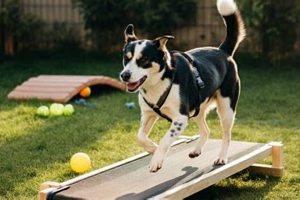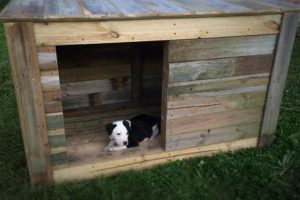A do-it-yourself canine bathing station offers a customized solution for pet owners who prefer to groom their dogs at home. Such setups range from simple repurposed materials to more elaborate constructions designed for comfort and efficiency. Examples include converting an existing utility sink, modifying a plastic storage container, or building a dedicated structure from wood or other durable materials.
Constructing a personalized dog bathing area can yield several advantages. It provides a controlled and familiar environment for the animal, reducing stress often associated with professional grooming services. Furthermore, it allows owners to adapt the bathing process to their dog’s specific needs and sensitivities, while potentially saving on grooming costs over time. The concept has gained traction with the rise of pet ownership and increasing awareness of animal welfare.
The following sections will detail various design considerations, material choices, and construction techniques for building functional and safe pet bathing facilities. These will encompass plumbing integration, ergonomic considerations, and safety features, with the ultimate goal of providing a comprehensive guide for creating an effective grooming space.
Tips for Constructing a Canine Bathing Station
The creation of a functional and safe bathing station for canines requires careful planning and execution. These tips outline essential considerations for a successful project.
Tip 1: Select Durable and Water-Resistant Materials: Opt for materials such as stainless steel, marine-grade plywood, or sealed concrete to withstand constant exposure to water and cleaning agents. These materials resist corrosion and bacterial growth, extending the lifespan of the structure.
Tip 2: Incorporate Proper Drainage: Ensure the bathing station includes a drain connected to the plumbing system. A hair strainer is crucial to prevent clogs and maintain efficient drainage. Consider a sloping floor towards the drain to facilitate water removal.
Tip 3: Design for Ergonomic Comfort: Account for the user’s posture during bathing. A raised platform or a tub at an appropriate height can minimize back strain. Install a non-slip surface inside the tub to prevent accidents.
Tip 4: Integrate Temperature Control: Connect the bathing station to a hot and cold water supply. A thermostatic mixing valve maintains a consistent water temperature, preventing scalding and ensuring the animal’s comfort.
Tip 5: Provide Secure Restraints: Install a secure tethering system to keep the dog safely in place during bathing. Adjustable restraints accommodate various dog sizes and prevent escape attempts.
Tip 6: Include Adequate Storage: Integrate storage shelves or cabinets to house shampoos, conditioners, towels, and grooming tools. This keeps the bathing area organized and prevents clutter.
Tip 7: Prioritize Safety Features: Round sharp edges and corners to prevent injury. Ensure all electrical connections are properly grounded and protected from water exposure.
Adhering to these guidelines facilitates the creation of a safe, efficient, and durable dog bathing station. Prioritizing material selection, ergonomic design, and safety features is crucial for a successful outcome.
The subsequent sections will delve into specific design plans and construction techniques, providing a more detailed approach to building a bespoke canine bathing solution.
1. Material Durability
Material durability is a foundational element in the successful construction of a do-it-yourself dog bathing tub. The frequent exposure to water, cleaning agents, and the potential for scratching or chewing necessitates the selection of materials that resist degradation. A failure to prioritize durability results in structural compromise, increased maintenance demands, and a shortened lifespan for the bathing station. For instance, using untreated wood in the tub’s construction would lead to rapid water absorption, promoting rot, mold growth, and eventual structural failure. Similarly, using thin plastic that is susceptible to cracking under pressure from a large dog will cause damage and necessitate repairs or replacement.
Stainless steel represents a frequently employed durable material due to its resistance to corrosion and ease of cleaning. Marine-grade plywood, when properly sealed with a waterproof coating, offers a balance of strength and water resistance. Concrete, if properly treated and sealed, can provide a robust and long-lasting base. The selection of these materials directly affects the tub’s ability to withstand the rigors of regular use and maintain its structural integrity over time. Consider plumbing fixtures as well. Brass or PVC pipes resist corrosion from water and soap exposure better than other materials.
Therefore, emphasizing material durability is paramount in the planning and execution of a homemade dog bathing station. Overlooking this aspect can lead to premature failure and negate the intended benefits of a cost-effective and customized grooming solution. A proactive approach to material selection, based on the principles of water resistance, strength, and longevity, ensures a valuable long-term investment in pet care.
2. Drainage Efficiency
Drainage efficiency represents a critical performance parameter for any do-it-yourself dog tub. Inadequate drainage directly translates to unsanitary conditions, increased cleaning effort, and potential damage to surrounding structures. A poorly designed drainage system leads to standing water accumulation, creating a breeding ground for bacteria, mold, and unpleasant odors. This situation not only compromises hygiene but also poses a health risk to both the animal and the owner. For instance, a tub lacking sufficient slope toward the drain will retain residual water and soap scum, requiring manual removal and potentially leading to skin irritation or infections for the dog. Consider a scenario where the drain line is undersized or improperly vented; this will result in slow drainage and potential backflow, further exacerbating the issue of standing water and unsanitary conditions.
The integration of a properly sized drain, typically 1.5 to 2 inches in diameter, coupled with an adequate slope (approximately 1/4 inch per foot) toward the drain, is essential for effective water removal. The inclusion of a hair strainer is imperative to prevent hair accumulation within the drain line, which can cause clogs and impede drainage. The selection of appropriate plumbing materials, such as PVC or ABS pipe, ensures resistance to corrosion and chemical degradation from cleaning agents. Furthermore, proper venting of the drain line prevents vacuum lock, facilitating smooth and continuous water flow. Without these critical design elements, the bathing station becomes inefficient and potentially detrimental to the well-being of both the animal and the owner.
In summary, the effectiveness of a homemade canine washing facility is inextricably linked to the drainage system. Prioritizing efficient drainage through proper design, material selection, and installation practices is crucial for maintaining a sanitary, functional, and long-lasting bathing solution. Failure to address this aspect can result in a multitude of problems, undermining the overall purpose of a customizable and cost-effective grooming station. Therefore, the drainage system should receive careful consideration during the planning and construction phases.
3. Ergonomic Height
Ergonomic height is a critical design consideration in the construction of a do-it-yourself dog tub, directly influencing the user’s comfort and safety during the bathing process. Proper ergonomic design minimizes physical strain and promotes efficient operation, contributing to a positive grooming experience.
- Reduction of Back Strain
An inappropriately low tub height necessitates excessive bending or stooping, increasing the risk of back strain and discomfort for the user. A tub elevated to a comfortable working height, typically between 36 and 42 inches, allows for a more upright posture, reducing stress on the lower back. This design aspect is particularly important for individuals who groom dogs frequently or have pre-existing back conditions.
- Improved Posture and Reach
Optimizing the tub’s height improves overall posture and allows for easier reach to all areas of the dog’s body. A taller tub eliminates the need to crouch or kneel, facilitating thorough cleaning and grooming. Furthermore, it provides better visibility of the dog, enabling more precise and controlled movements during washing and rinsing.
- Accessibility Considerations
Ergonomic height also impacts accessibility, particularly for individuals with limited mobility. A tub that is too high may be difficult to access, while one that is too low can be challenging to exit. Incorporating features such as steps or a ramp can enhance accessibility and accommodate a wider range of users, ensuring a safe and comfortable bathing experience for both the dog and the owner.
- Enhanced Safety
Proper ergonomic height contributes to improved safety by reducing the likelihood of slips, trips, and falls. Maintaining an upright posture promotes better balance and stability, minimizing the risk of accidents during the bathing process. The elimination of awkward bending and reaching movements also reduces the potential for muscle strains and other injuries.
The integration of ergonomic principles into the design of a homemade dog washing station translates to a more comfortable, efficient, and safer grooming experience. By carefully considering the user’s physical needs and limitations, a do-it-yourself project can effectively mitigate the risks associated with improper posture and awkward movements, ultimately enhancing the overall quality of pet care.
4. Temperature Control
Temperature control is a vital component in the design and utilization of a do-it-yourself dog tub. Maintaining appropriate water temperature is essential for the animal’s comfort, safety, and overall well-being during the bathing process. Insufficient temperature regulation can lead to discomfort, stress, and potential health complications for the dog.
- Prevention of Scalding and Hypothermia
The primary role of temperature control is to prevent extreme temperature exposure. Scalding can occur with excessively hot water, causing burns and significant distress. Conversely, excessively cold water can induce hypothermia, particularly in small or young dogs. Maintaining a consistent and moderate water temperature mitigates these risks, ensuring a safe bathing environment. A practical example is the use of a thermostatic mixing valve, which automatically regulates water temperature to a pre-set level, preventing fluctuations and ensuring a consistently safe bathing temperature. This component is critical in preventing accidental temperature spikes that can harm the animal.
- Promotion of Relaxation and Cooperation
A comfortable water temperature encourages relaxation and cooperation from the dog during bathing. Dogs are more likely to resist or become agitated if the water is too hot or too cold. A moderate and consistent temperature creates a more positive bathing experience, reducing stress and making the process easier for both the dog and the owner. This is achieved by using devices like water heater boosters or temperature gauges that help monitor and maintain desired temperature levels. A relaxed dog is easier to handle, reducing the risk of accidental injuries to both the animal and the person doing the washing.
- Effective Cleaning and Shampoo Performance
Water temperature influences the effectiveness of cleaning and the performance of shampoos and conditioners. Warm water is more effective at dissolving dirt, grime, and oils from the dog’s coat, allowing for a more thorough cleaning. Additionally, many dog shampoos are formulated to work optimally at specific temperatures. For example, a medicated shampoo designed to treat skin conditions may require warm water for proper activation and penetration. An improperly heated or cooled water supply may lead to diminished cleaning results.
- Customization for Breed and Coat Type
Different dog breeds and coat types may benefit from slight variations in water temperature. Short-haired breeds might be more sensitive to cooler temperatures, whereas long-haired breeds may require slightly warmer water to ensure thorough cleaning. A temperature-adjustable system allows for customization to suit the individual needs of the dog. This can be achieved with precise temperature adjusting valves and gauges allowing to set the accurate temperature depending on the dog.
In conclusion, temperature control is an indispensable element of a well-designed do-it-yourself dog tub. Its function goes beyond simple comfort, encompassing safety, stress reduction, and enhanced cleaning effectiveness. By prioritizing temperature regulation, the owner can create a safe and enjoyable bathing experience for their canine companion, while also maximizing the effectiveness of grooming products and techniques. This, ultimately, contributes to the dog’s overall well-being and hygiene.
5. Safety Restraints
The integration of safety restraints within a do-it-yourself dog tub is paramount for both the animal’s and the handler’s well-being. The primary cause of injury during home grooming sessions stems from unrestrained movement, potentially leading to slips, falls, or escape attempts by the dog. In the confined space of a bathing area, these actions can result in contusions, sprains, or lacerations. The inclusion of safety restraints directly mitigates these risks by limiting the dog’s mobility and providing a secure anchor point. For instance, a small breed attempting to jump out of the tub could sustain serious injury, while a large breed could inadvertently knock over grooming tools or cause the handler to lose balance. Safety restraints therefore serve as a preventive measure, minimizing the potential for adverse incidents.
Effective safety restraint systems typically involve a combination of features, such as adjustable tethers, non-slip surfaces within the tub, and strategically positioned grab bars. Adjustable tethers allow for customized restraint based on the dog’s size and temperament, while non-slip surfaces enhance traction and prevent accidental slips. Grab bars provide additional stability for the handler, particularly when maneuvering around the dog. A real-world example illustrates the importance of these features: a dog with a history of anxiety during baths was successfully calmed and safely groomed through the use of a secure tether and a rubberized mat within the tub. Without these measures, the grooming session would have been fraught with potential for injury and stress for both parties.
In summary, safety restraints are not merely an optional accessory but a critical component of a functional and responsible homemade dog bathing solution. They address the inherent risks associated with unrestrained animal movement, promote a more controlled and secure grooming environment, and ultimately contribute to the safety and well-being of both the dog and the handler. While design considerations and material choices are essential in constructing a bathing facility, neglecting safety restraints represents a significant oversight with potentially serious consequences. Their inclusion is therefore a non-negotiable aspect of responsible pet care and DIY construction practices.
6. Accessibility
Accessibility is a critical element in the design and construction of a do-it-yourself dog tub, dictating its usability for both the animal and its handler. A bathing station lacking accessible features presents challenges, particularly for aging, injured, or small-breed dogs, as well as owners with physical limitations. Addressing accessibility concerns is essential to ensure a safe, comfortable, and efficient grooming process.
- Ramp or Step Integration
The inclusion of a ramp or steps facilitates entry and exit for dogs with mobility issues. High-sided tubs without assistive devices pose a significant barrier, potentially leading to injuries from jumping or struggling. A gently sloping ramp with a non-slip surface allows dogs to walk in and out of the tub with ease. Similarly, sturdy steps of appropriate height provide a manageable alternative for smaller breeds or those with joint problems. The absence of these features restricts the tub’s usability and may necessitate lifting, which can be difficult or unsafe for both the owner and the animal.
- Adjustable Height Features
Adjustable height mechanisms enhance accessibility for handlers of varying statures or those with physical limitations. A tub that is either too low or too high can cause back strain, awkward posture, and difficulty reaching all areas of the dog. The ability to adjust the tub’s height allows for customization to the user’s specific needs, promoting comfort and reducing the risk of injury. For instance, a crank system or hydraulic lift enables effortless height adjustments, accommodating users of different heights or those who may be seated during the grooming process. Fixed-height tubs lack this versatility and may not be suitable for all users.
- Spacious Interior Dimensions
Adequate interior dimensions ensure that the dog has sufficient room to move around comfortably during the bathing process. A cramped tub restricts movement, leading to anxiety, agitation, and potential resistance from the animal. Ample space allows the dog to stand, turn, and lie down as needed, minimizing stress and promoting cooperation. This is particularly important for larger breeds, which require a larger bathing area to accommodate their size and movements. Restrictive dimensions can also hinder the handler’s ability to effectively clean and groom the dog.
- Clearance and Maneuvering Space
Sufficient clearance around the tub allows for ease of movement and maneuverability for the handler. A bathing station located in a confined space can restrict access to essential supplies, limit the ability to reach all areas of the dog, and increase the risk of accidents. Adequate clearance provides ample room for the handler to move around the tub, access grooming tools, and assist the dog as needed. This aspect is especially important for individuals with mobility issues or those who require assistance during the grooming process. Inadequate clearance can create a hazardous and inefficient bathing environment.
Addressing accessibility considerations in the design and construction of a do-it-yourself dog tub is crucial for creating a safe, comfortable, and user-friendly grooming solution. Incorporating features such as ramps, adjustable height mechanisms, spacious dimensions, and adequate clearance ensures that the bathing station is accessible to a wide range of users and dogs with varying needs. Prioritizing accessibility enhances the overall functionality and value of the do-it-yourself project, promoting positive grooming experiences for both the animal and its owner.
7. Cleaning Ease
Cleaning ease represents a crucial aspect of do-it-yourself dog tub design and construction. A bathing station that is difficult to clean negates many of the benefits associated with home grooming, potentially leading to unsanitary conditions and increased maintenance demands. Effective design prioritizes materials and construction techniques that minimize cleaning effort and promote hygiene.
- Surface Material Selection
The choice of surface materials directly impacts cleaning ease. Non-porous materials, such as stainless steel, fiberglass, or sealed acrylic, resist the absorption of water, soap scum, and organic matter. This characteristic simplifies the cleaning process and prevents the growth of bacteria and mold. Conversely, porous materials, such as untreated wood or unsealed concrete, are more susceptible to staining, odor retention, and microbial growth, requiring more rigorous cleaning methods and potentially leading to unsanitary conditions. An example is the use of a smooth, seamless acrylic tub surface, which can be quickly wiped down with a mild detergent, compared to a textured surface that traps dirt and debris.
- Drainage Design
An efficient drainage system is integral to cleaning ease. A properly sloped floor and a well-positioned drain ensure that water and debris are effectively removed from the tub, preventing the accumulation of residue. A drain with a removable hair strainer further simplifies cleaning by capturing hair and preventing clogs. The absence of these features necessitates manual removal of standing water and debris, increasing cleaning effort and potentially leading to drain blockages. A strategically placed drain and proper floor slope minimize the manual labor required to clear water and debris.
- Accessibility and Design Features
Design features that enhance accessibility also contribute to cleaning ease. A tub with smooth, rounded corners and minimal crevices eliminates potential traps for dirt and debris, simplifying the cleaning process. Adequate clearance around the tub allows for easy access to all surfaces, facilitating thorough cleaning. Removable components, such as spray nozzles or shampoo trays, can be easily cleaned and disinfected. These thoughtful design elements minimize the time and effort required to maintain a sanitary bathing environment. Open designs without enclosed corners allow for easy cleaning of debris and soap.
- Resistance to Chemical Degradation
Materials used in the construction of the tub should demonstrate resistance to chemical degradation from commonly used cleaning agents. Frequent exposure to harsh detergents, disinfectants, and sanitizers can damage certain materials, leading to discoloration, cracking, or corrosion. Selecting materials that are specifically designed to withstand chemical exposure ensures the tub’s longevity and simplifies the cleaning process. For instance, using stainless steel hardware instead of chrome-plated components prevents rust and corrosion, reducing maintenance demands. When cleaning with any chemical it is important to test a small area for prolonged exposure effect.
In conclusion, cleaning ease is an essential consideration in the design of a do-it-yourself dog tub. By prioritizing appropriate materials, efficient drainage, accessible design features, and resistance to chemical degradation, the bathing station can be easily maintained in a sanitary condition, promoting hygiene and minimizing the time and effort required for cleaning. These considerations are a fundamental part of planning to have a diy dog tub for your lovely pet.
Frequently Asked Questions About DIY Dog Tubs
This section addresses common inquiries regarding the design, construction, and maintenance of do-it-yourself dog bathing stations. The intent is to provide clarity and guidance based on established best practices.
Question 1: What are the essential considerations for selecting materials for a do-it-yourself dog tub?
Material selection should prioritize durability, water resistance, and ease of cleaning. Stainless steel, marine-grade plywood with a waterproof sealant, and reinforced plastic are viable options. Avoid porous materials such as untreated wood, as they are susceptible to water damage and microbial growth. Plumbing components should be corrosion-resistant.
Question 2: How can efficient drainage be ensured in a homemade dog bathing station?
Efficient drainage necessitates a properly sloped floor (approximately inch per foot) towards a drain of adequate diameter (typically 1.5 to 2 inches). The inclusion of a hair strainer is essential to prevent clogs. Ensure the drain line is properly vented to facilitate smooth water flow. The drain should connect directly to the plumbing system.
Question 3: What ergonomic factors should be considered when designing a do-it-yourself dog tub?
Ergonomic design should focus on minimizing strain for the user. A tub height between 36 and 42 inches is generally recommended to reduce bending. Incorporate a non-slip surface within the tub. For dogs unable to jump, consider a ramp or steps for easier access. Ensure adequate space around the tub for maneuverability.
Question 4: How can appropriate water temperature be maintained in a do-it-yourself dog tub?
The installation of a thermostatic mixing valve is recommended to maintain a consistent and safe water temperature, preventing scalding or chilling. A temperature gauge allows for visual monitoring of the water temperature. Ensure hot water supply is adequate, and consider a water heater booster if necessary.
Question 5: What are the recommended safety features for a do-it-yourself dog bathing station?
Safety features should include adjustable tethers to restrain the dog, non-slip surfaces within the tub, and rounded edges to prevent injury. All electrical connections must be properly grounded and protected from water exposure. A readily accessible shut-off valve for the water supply is also advisable.
Question 6: How should a do-it-yourself dog tub be cleaned and maintained?
Regular cleaning with a mild detergent is recommended to prevent the build-up of soap scum and debris. The drain should be inspected and cleared of hair regularly. Avoid abrasive cleaners that could damage the tub’s surface. Inspect plumbing connections periodically for leaks. Sanitize the tub regularly with a pet-safe disinfectant.
The design and construction of a homemade dog bathing facility requires careful consideration of materials, ergonomics, safety, and maintenance. Adherence to established best practices ensures a functional and hygienic grooming solution.
The subsequent section will provide practical guidance on specific design plans and construction techniques for building a personalized canine bathing station.
Conclusion
The construction of a diy dog tub represents a viable solution for pet owners seeking a customized and potentially cost-effective grooming environment. This exploration has detailed critical aspects ranging from material selection and drainage efficiency to ergonomic considerations and safety protocols. Adherence to these principles ensures the creation of a functional and durable facility tailored to the specific needs of the animal and its handler.
The decision to undertake a diy dog tub project warrants careful planning and diligent execution. A well-designed and constructed bathing station not only facilitates efficient pet care but also contributes to the animal’s well-being and the owner’s convenience. Prioritizing safety and functionality throughout the process will yield a long-term investment in responsible pet ownership.







